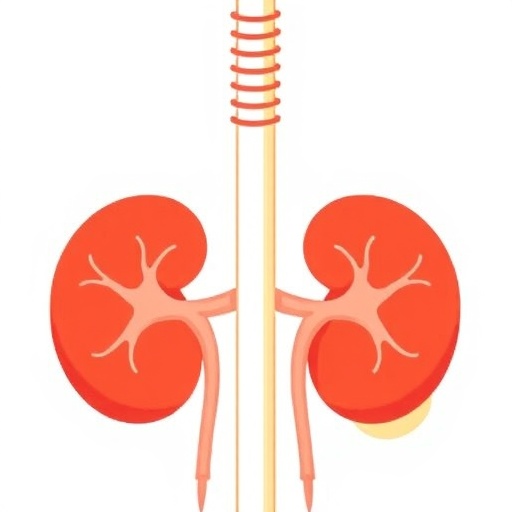
In the ever-evolving landscape of oncological interventions, microwave ablation (MWA) has emerged as a transformative modality for managing hepatic hemangiomas (HH), benign vascular tumors of the liver. While its minimally invasive nature and targeted efficacy have garnered widespread acclaim, recent clinical insights reveal a nuanced complication profile that necessitates vigilant perioperative management. Among these, acute kidney injury (AKI) stands out as a formidable postoperative challenge, demanding both prompt recognition and sophisticated therapeutic strategies.
Microwave ablation operates by delivering high-frequency electromagnetic waves that induce rapid oscillation of water molecules within tissue, resulting in localized heat generation. This controlled hyperthermia leads to coagulative necrosis of the target lesion without necessitating open surgery. For benign hepatic tumors such as hemangiomas, MWA provides an appealing alternative to resection, boasting shorter recovery times and diminished systemic impact. Nonetheless, the intricate vascular architecture of hemangiomas, characterized by fragile and voluminous blood-filled spaces, introduces unique physiological stressors during ablation.
In clinical observations spanning nearly four years, a comprehensive retrospective analysis identified a minuscule yet critical subset of patients who developed AKI subsequent to MWA of HH. Although such occurrences were rare, their severity underscores the imperative for enhanced understanding of the pathophysiological interplay and the refinement of perioperative protocols. Two documented cases of AKI in 117 patients serve as a sentinel alert, emphasizing the delicate balance between therapeutic efficacy and collateral organ safety.
The pathogenesis of AKI in the context of MWA appears intricately linked to hemoglobinuria, a phenomenon identified intraoperatively and postoperatively in affected individuals. Hemoglobinuria results from massive intravascular hemolysis induced by the thermal destruction of erythrocytes within the ablation zone. The release of free hemoglobin imposes substantial nephrotoxic effects through multiple mechanisms, including oxidative stress, tubular obstruction, and inflammatory cascades, collectively imperiling renal function.
Clinicians witnessed that the prompt identification of hemoglobinuria is paramount in mitigating progression to overt AKI. Subtle changes in urine coloration during surgery signal the onset of hemolysis, warranting expedient investigation and intervention. Such real-time monitoring bridges the gap between procedural execution and organ protection, highlighting the critical role of multidisciplinary vigilance.
Therapeutic countermeasures implemented in these cases embraced a multipronged sequential approach centered around renal preservation and metabolic stabilization. Sodium bicarbonate-induced alkalization of urine formed the cornerstone of treatment, aimed at reducing hemoglobin polymerization and promoting solubility to prevent tubular deposition. This pharmacological strategy attenuates oxidative injury and maintains a favorable microenvironment within the nephron.
Concomitant aggressive fluid resuscitation was employed to sustain intravascular volume and encourage diuresis, thereby facilitating the clearance of nephrotoxic hemoglobin breakdown products. The delicate modulation of fluid balance remained essential to avoid the pitfalls of both hypovolemia and fluid overload, which could exacerbate renal compromise or precipitate cardiorespiratory complications.
In cases wherein conservative measures proved insufficient, diuretic therapy was judiciously introduced to amplify urinary flow rates, further diminishing contact time between toxic agents and renal tubular cells. The judicious use of loop diuretics served not only as a facilitator of hemoglobin excretion but also as a tool to manage volume status dynamically according to evolving clinical parameters.
Remarkably, dialysis support was considered and implemented expediently when indicated, providing an extracorporeal means of removing circulating toxins and correcting fluid-electrolyte imbalances. This intervention underscores the necessity for access to advanced nephrological services within centers conducting MWA, ensuring seamless escalation of care when required.
The clinical outcomes of these meticulously managed patients were encouraging. Renal function, initially compromised by AKI, demonstrated progressive recovery, culminating in normalization of biochemical markers and restoration of physiological homeostasis. This recovery trajectory provides compelling evidence that AKI secondary to MWA-induced hemoglobinuria is reversible under timely and appropriate interventional paradigms.
These insights delineate a critical framework not only for the management of AKI following MWA but also for refining patient selection and intraoperative monitoring protocols. Preoperative assessment should encompass renal risk stratification, with heightened caution exercised in patients harboring pre-existing renal insufficiency or associated comorbidities.
Furthermore, technological advancements in MWA apparatus and ablative strategies may evolve to minimize hemolytic burden. Optimization of power settings, ablation duration, and energy delivery patterns could potentially mitigate erythrocyte destruction, thereby reducing the incidence of hemoglobinuria-induced nephrotoxicity.
From a broader perspective, this emerging understanding of perioperative AKI demands cross-disciplinary collaboration among hepatologists, interventional radiologists, anesthesiologists, and nephrologists. Harnessing collective expertise facilitates not only the early recognition and management of complications but also the development of institution-wide protocols enhancing patient safety.
In summary, while microwave ablation stands as a potent and generally safe technique for treating hepatic hemangiomas, the advent of acute kidney injury tied to hemoglobinuria necessitates heightened clinical awareness. The combination of sodium bicarbonate alkalization, fluid resuscitation, diuretic therapy, and dialysis, administered in a timely fashion, heralds a new standard for comprehensive perioperative management. This paradigm ensures that even the rarest of complications can be rendered transient, preserving kidney function and optimizing therapeutic outcomes.
Ongoing research with larger cohorts and prospective designs will be paramount to refine understanding of AKI incidence, risk factors, and best practices in this setting. Moreover, translational studies exploring the molecular underpinnings of thermal injury-induced hemolysis and renal toxicity may pave the way for novel protective agents or preventative therapies.
The promise of microwave ablation in hepatic hemangioma treatment remains undiminished; however, this nuanced complication profile enriches our collective clinical acumen. By integrating vigilant monitoring, rapid response, and tailored therapeutic approaches, the medical community can continue to advance minimally invasive oncology toward safer, more effective patient care.
Subject of Research: Acute Kidney Injury following microwave ablation treatment of hepatic hemangioma and its perioperative management
Article Title: Perioperative management of acute kidney injury after microwave ablation of hepatic hemangioma
Article References:
Hu, B., Huan, HB., Tu, YL. et al. Perioperative management of acute kidney injury after microwave ablation of hepatic hemangioma. BMC Cancer 25, 810 (2025). https://doi.org/10.1186/s12885-025-14214-9
Image Credits: Scienmag.com
DOI: https://doi.org/10.1186/s12885-025-14214-9
Tags: acute kidney injury risk factorsclinical insights on microwave ablationcoagulative necrosis in liver tumorscomplications of minimally invasive oncologyManaging acute kidney injurymicrowave ablation for hepatic hemangiomasperioperative management of kidney injurypostoperative challenges in microwave ablationrefining protocols for acute kidney injury managementretrospective analysis of MWA complicationstherapeutic strategies for AKI post-MWAvascular architecture of hemangiomas





